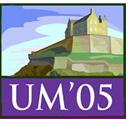
WORKSHOP on Decentralized, Agent Based and Social Approaches to User Modelling
(DASUM 2005)
organized in conjunction with
10th International Conference on User Modeling
July 25, 2005, Edinburgh, UK
| => Home <= |
| : Program : |
| : Topics : |
| : Submission : |
| : Dates : |
| : Organization : |
| : Links : |
| : Proceedings : |
| : Panel : |
| : Summary : |
| : CFP : |
Please note that UMí05 has extended the EARLY REGISTRATION DEADLINE for workshop participants until April 11th, 2005. The registration information is available at the main conference Web site.
Time is ripe to discuss decentralized approaches to user modelling, since decentralized applications are becoming prevalent both in web-based and mobile/ ubiquitous environments. Such applications include personal guides or helpers for navigation or ambient devices, integrated web-sites (e.g. newspapers or magazines), portals (e.g. Yahoo), e-commerce web-sites (e.g. Amazon, e-Bay), or recommender sites (e.g. MovieLens). Emerging classes of such applications are loosely coupled systems.
Both, web-service-based and ubiquitous computing applications can be considered as conglomerates of independent, autonomous services developed by independent parties, which have not been integrated by design, but integrate dynamically at run-time, as the need arises. A frequently used metaphor is a free-market of services where the user is a shopper that buys a larger service composed dynamically by smaller services. For example, e-learning courses assembled dynamically from independently created repositories of learning objects and tailored to the needs of a particular learner. Another area where decentralized and social approaches to user modelling are applied is the enrichment of profile data (obtained from whatever source) by information from completely unrelated sources, for example, demographic and sociographic data. An example for this is the Lifestyle Finder and its method of demographic generalization.
In ubiquitous environments distributed sensors follow a userís movements and based on the userís typical tasks or preferences learned from history and features of the context appropriate adaptations of the interface, ambient features of functionality are made. Since context information is very important for adaptation in mobile/ ubiquitous applications, generalized consistent user models developed over long periods of time are less likely to be useful. Decentralized user modeling in this application domain studies how to combine fragmentary / episodic user data and make most sense of it in the specific context with limited processing resources. This is a very challenging problem, since unlike web-based systems, where the assembled service is accessed through one point, usually a web portal, in a ubiquitous environment there is no central integration point, but the service is dynamically composed by several agents that need to coordinate and negotiate in order to provide the most suitable adaptation for the user. In addition, in ubiquitous environments, the dynamics is much higher, the context factors more diverse, and the computing resources of the agents / services and their connectivity more limited.
While systems with integrated design can rely on centralized user model servers, the systems consisting of independent autonomous services can not since the range of possible intentions and preferences of a user is not known at design time, since they are strongly dependent on the type of service, domain etc. A centralized user model, for example, a UM server is too restrictive since it imposes a list of user features that it can represent and a non-negotiable format of representation, APIs, and protocol. Only services that can make use of these features for their adaptation purposes will be able to use the server. In a mobile or ubiquitous environment so the distribution of user profile fragments is natural; users are followed by different devices and the user information collected by the devices typically makes sense only in the context (e.g. for a short period of time, for a given place etc.). A centralized user model also introduces a central point of failure, and while reliability can be increased by introducing mirrors or distributing the load on several servers, the problem of synchronization and coordination of the mirror servers increases the cost. For large web sites like eBay and Amazon, this may not be a problem, but for small players it may be too expensive. An alternative decentralized approach allows small players or devices (e.g. individual or clusters of web-services, agents, individual networked applications) to share their own locally created simple user models or user data and interpret the data in context for the specific adaptation purposes.
In decentralized settings, each small player (agent, smart sensor, mobile device, learning object, application, web-service) maintains a small user model / profile, as needed for its own purposes of adaptation. These models are updated by the players sporadically, whenever they interact with users. However, the players can also talk with other players who interact with users and build their own models to exchange user information, and to be more up-to-date. In this way, through communication, the agents leverage the benefits of the UM efforts done by many modelers. Instead of one central UM acting as a sink where the subscribed applications report their user data, or instead of having isolated UMs for each application, we have a community of adaptive applications sharing user information.